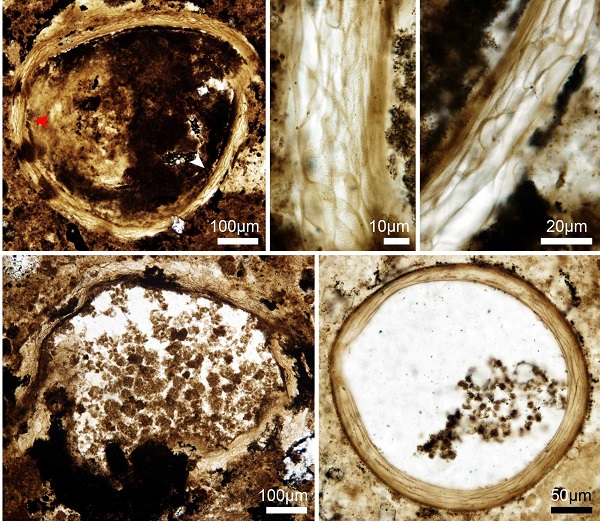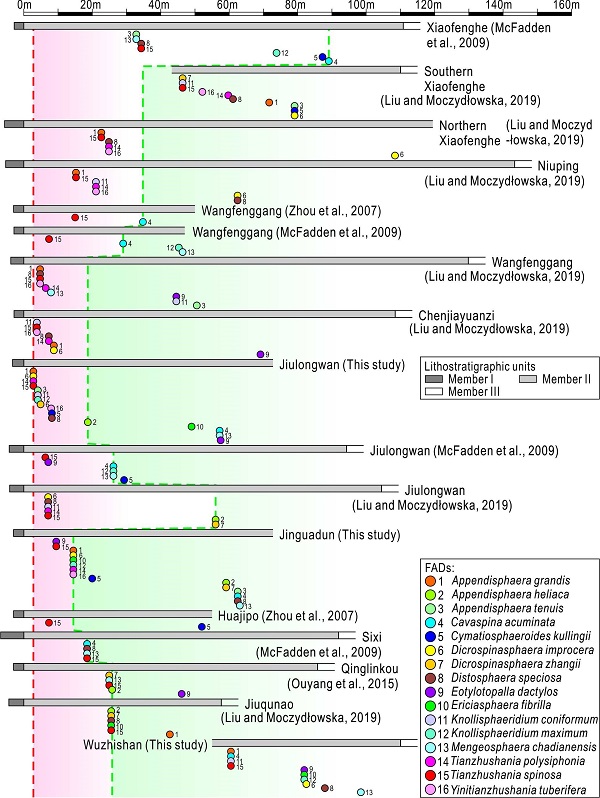After more than one billion years of evolution and extreme conditions of the Neoproterozoic global glaciations, eukaryotic life began to thrive and diversify globally in the Ediacaran Period. This event initiated from the wide occurrence and diversification of the Ediacaran acanthomorphic acritarchs and multicellular algae. Previous studies have shown that the eukaryotic radiation continued from the Ediacaran Period to the Cambrian explosion, with when and how the earliest Ediacaran acanthomorphs occurred and diversified remaining not fully discussed, hampering our understanding to the initiation of the first global radiation of eukaryotes in Earth history.
To resolve those problems, researchers from the Nanjing Institute of Geology and Palaeontology, Chinese Academy of Sciences(NIGPAS), collaborating with researchers from the Virginia Tech., USA, have been working on the fossiliferous Ediacaran Doushantuo Formation in South China for decades, and one of their studies was published recently on Precambrian Research.
Based on 1547 acanthomorphic acritarch specimens from the Doushantuo Formation at 3 sections, this work identified 24 genera and 69 species, including two new genera, six new species, five unnamed species, and three possible new forms tentatively placed in open nomenclatures, and discussed the temporal and spatial distribution of acanthomorphic acritarchs of the Doushantuo Formation, as well as implications for Ediacaran biostratigraphy. This paper reported acanthomorphs from the lowest chert nodule horizon of the Doushantuo Formation, with considerably high diversity, indicating a possible earlier appearance of these eukaryotic organisms, which has not been captured in the fossil record due to the lack of proper taphonomic conditions below this horizon. This finding also indicates that the First Appearance Data (FAD) of any acanthomorphic acritarch from this lowest chert nodule horizon in basal Member II may not serve as a good criterion for the base of the Second Ediacaran Stage (SES), thus other geological records are needed in searching for the basal boundary of SES.
Upsection, altogether 21 species occurred within the 20 m strata above the cap dolostone, exceeding half of the total number of species (65.6%) from Member II of the Doushantuo Formation at Jiulongwan. Based on published cyclostratigraphic data, these results show that Ediacaran acanthomorphs diversified rapidly, reaching a considerably high diversity within about 10 Myrs after the end of Marinoan glaciation. In addition, combined with published acritarch data, this study discussed problems relating with biostratigraphic data from "composite sections", which had been widely used in previous studies, and proposed some regionally traceable taxa for future biostratigraphic studies of the Doushantuo Formation.
This study was supported by the National Key R & D Program of China, National Natural Science Foundation of China, the Strategic Priority Research Program (B) of Chinese Academy of Sciences, and the U. S. National Science Foundation.
Reference: Ouyang, Q., Zhou, C., Xiao, S., Guan, C., Chen, Z., Yuan, X., Sun, Y., 2021. Distribution of Ediacaran acanthomorphic acritarchs in the lower Doushantuo Formation of the Yangtze Gorges area, South China: Evolutionary and stratigraphic implications. Precambrian Research 353, 106005. https://doi.org/10.1016/j.precamres.2020.106005.

Newly erected genus and species Crassimembrana crispans gen. et sp. nov. and a new form Crassimembrana cf. C. crispans

Emended species Weissiella brevis emend. in this study

First appearance data (FADs) of some regionally traceable acanthomorph taxa in Member II from the Yangtze Gorges area
Download:
